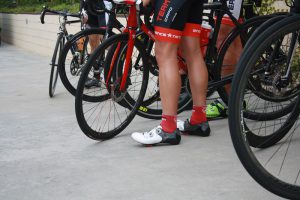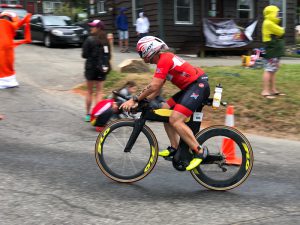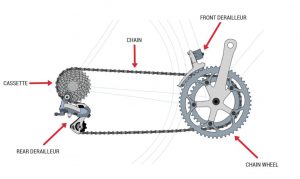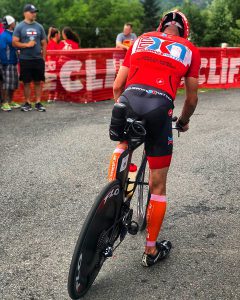Gearing Up: How to Set Up Your Triathlon Bike for Optimal Success
As you move into the race preparation part of your season, one of the most important things you can do is ready your body and your equipment. While both areas require attention and discipline, the return on investment for each aren’t equal by any means. In this article, we’ll walk you through the process of making sure your bike is ready for speed on race day.
Access Our Insider Triathlete Email Series
Start with the Low Hanging Fruit
The right equipment in the hands of the smart athlete will trump fitness every time. This is why equipment selection and racing strategy (such as our Four Keys of Race Execution) are such a huge part of the Endurance Nation experience.
90% of athletes are laser-focused on their fitness, so don’t spend all of your time fighting your way to the front of that glycogen-crazed mob. Out think them instead.
In the case of cycling, the number one thing to sort out on your bike is the gearing. We’ve all tried to “solve” a long steep hill with the wrong gear. You simply can’t be in that position on race day and continue to bike well, much less run well off the bike.
112 Miles = Plenty of Time for Benefits to Accrue
One of the easiest ways to improve your race experience is to maximize the gearing on your bike. The bike is the longest leg of your race, any improvement here is magnified. Remember the bike takes you approximately twice as long as the run; this means improvements on the bike yield approximately a 2X return. The swim is so short compared to usually 20% of your bike time so improvements there are worth only 1/5 of a bike improvement.
While most people focus on the “sexy” improvements related to their bike, those aren’t necessarily the parts of the biggest return. When I say sexy I mean new aero bars, high-tech components, race wheels, new helmets, matching shoes, etc. You get the idea. While each of those items has its own return, none of them can compare to the effect that having a proper gearing bike bring to your race performance.
What Is A Successful Bike Ride?
Before you break out your gearing calculator, it’s important to define our desired end state. What are we trying to achieve?
Inside Endurance Nation we believe there is no such thing as a good bike followed by a poor run. The finish line is after the run; no matter how fast Or how hard you ride, you still need to be able to run well.
- The first part of this is having a race plan with target Power and/or Heart Rate Zones. This will help you make sure that your effort is being used appropriately across the course.
- The second part of this is having a good bike fit. Spending time in the aero bars should not be an issue. Comfort and speed go hand in hand on race day, and the only way to truly address this is via a quality bike fit.
- The third part is the simplest of them all…spend time doing the “work” of training in order to get stronger and fitter.
But What About My Gearing?
Proper gearing is important because your fitness and the conditions of the day overlaid on the course, give you a predetermined range of speeds.
It’s also important to remember some baseline facts:
- We can’t change the course.
- We can’t change the conditions.
- It’s too late to change your fitness.
But we can — through your gearing — improve the mechanical advantage you have on the course relative to your competition.
Part One: Gearing 101
- The first step is to get to know the gears you currently have on your bike.
- The second step is to make sure those gears match your cycling ability level.
- Then the third step is to get out and practice on those gears given your body type and goals for race day
How To Find Out Your Current Gearing
The easiest way to do this is to determine the chainrings you currently have on your bicycle. Don’t ignore this step! Most “stock” triathlon bikes come with fairly primitive gears that won’t be used other than on the flat and open road.
Using two fingers, place one on top off a tooth on the chain ring and start counting there at “one.” Then you take the other finger and count the remaining teeth all the way around in a circle until you get back up to the placeholder finger . Front and small chainrings have a large amount of teeth, so take your time.
The next step is to repeat this for the largest and the smallest cogs on your rear cassette. This will tell you the top of the low end of your range and give you/your mechanic very good idea of what’s between those ranges as well.
Endurance Nation Baseline Bike Gears
Here are the gear ratios that we recommend based on ability levels:
Advanced Cyclist
- 11-Speed Gearing Systems:
- Front Chainring: 52/36 “super compact”
- Rear Cassette: 11/28 for hilly courses, /23 or 11/25 for other courses.
- 10-Speed Gearing Systems:
- Front Chainring: 50/34 compact
- Rear Cassette: same as above.
Beginner to Intermediate Cyclist
- 10 and 11-Speed Gearing Systems:
- Front Chainring: 50/34 compact
- Rear Cassette: 12/28 for most courses, consider a /30 or /32 rear cassette for extremely hilly courses.
Gearing 2.0 — Your Cycling Body Type
It’s important to know your body type so you can identify the weakness you are trying to solve with gearing.
Middle of the road cyclists… isn’t great (or bad) at either the climbing or the TT efforts, so they’ll need an all-around type of gearing. In this case, the stock gearing guidance from ^above^ by ability level will suffice.
If you are built like a traditional climber… then you’ll be quite fluid over the steep stuff with your minimal weight penalty. In this case, you’ll prefer a cassette range that allows you to work the hills with the understanding that pushing “big gears” on the downhill won’t really work for you.
- Front Ring: No Changes from baseline of 52/36 (11 spd) or 50/34 (10 spd)
- Rear Cassette: 11/28, with a bias towards Smaller ratio changes/gaps from 20t up to 28t.
Bigger cyclists might enjoy powering the rollers… but you’ll quickly exceed your target zones on the steeper climbs. You’ll want bigger “big” gears but a smaller “small” gears to make sure you can cover the bases you need. This is best achieved by tweaking the front ring set up and leaving your cassette alone.
- Front Ring: No Changes from baseline of 54/36 (11 spd) or 52/34 (10 spd).
- Rear Cassette: 11/30 or 11/32 for hillier courses. This means bigger gaps in the middle of the cassette but you will be okay at either extreme.
Part Two: Gearing In Action
So now you have the right gears, what do you do with them? In this section, you will learn just how we want you to execute the bike with your newly discovered gearing efficiency.
Remember that talk about Race Execution above?
On the bike, good race execution means effectively flattening the course — not working too hard up the hills — so that you can work over and down the hills and build momentum.
With the right gearing selection, you can take your race execution game one step further and distribute your efforts in places where it will yield maximum speed (aka results) for you.
If you don’t have the proper gearing, then the course itself will demand extra watts from you on the steeper or more technical portions. You will have to “pay back” that effort by backing off on the downhills and flat sections where free speed is available. If you don’t choose to make that adjustment on the bike, the race will force you to do it when you hit the run.
Better Gearing = Better Momentum
The easiest way to explain momentum is to imagine you riding around your favorite loop on a single speed bike. On the downhills, there will be very little tension on the chain and you’ll get a nice high cadence as you are rolling. On the flats, you’ll feel more of a steady resistance, even though it is manageable.
But the hills is where you will clearly feel the difference between momentum and gravity. There is a point in time on every hill where climbing moves from floating up that hill to having to really work. Better gearing will help you reduce the time you spend “genuinely working” on the bike (aka you’ve lost momentum) and it should also be able to reduce the perceived cost of that work (being able to choose your preferred gearing/cadence).
The Downhill Gearing Advantage (Low Torque Cycling)
There’s a point where you’ll “run out” of gears on a downhill. Also referred to as “spinning out” this is the point where you tuck and get aero.
If you choose your gearing properly, you can make sure that you have larger gears for the downhills. With these gears, you’ll be able to soft-pedal down the hill and maintain your momentum off the hill into the next section of the course.
The advent of 11-speed cassettes means that you can have an 11 cog on the rear cassette to target these High Speed/Low Torque situations.
This is a consideration for a course with extended descents where that speed/time can add up.
The Uphill Gearing Advantage (High Torque Cycling)
There are many different forms of climbing, from short and steep to extended low grade climbs to those pesky rolling hills. All of these involve finding the right gearing that will allow you to sustain the right effort for the duration of the climb, over the course of the ride, and still set up your run.
When you choose your cassette you’ll need to make sure that the transitions between key gears are smooth. Plus/minus five rpms of cadence is fairly imperceptible. Move to a larger gap because of changes you made to the upper/lower end of the gears will make smooth shifting fairly impossible.
And you’ll want that smooth shifting so you can toggle the gears to keep your effort be consistent as you enter the hill. Once momentum is lost and you start to fight gravity, you’ll want a gear that will allow you to comfortably continue the climb.
If you normally ride at a cadence of 90 rpms, you could realistically climb well at 80 rpms in your small ring with little difficulty. If the course you are going to race has climbs that will force you out of that zone, you’ll need to make a different gearing selection.
REMEMBER: The last thing you want to do is stand and climb. It’s very inefficient when done incorrectly, and it’s very hard to do on a TT bike set up.
The Combined Advantage
With the right uphill and downhill gearing, you’ll be able to make the most of your fitness without compromising the run. You’ll smoothly enter the hill and settle into your rhythm. As you crest the top, you can begin to shift as you feel the resistance of the climb fade, Focus on gaining speed quickly so you can either (A) rest when you spin out or (B) reduce the effect of the next hill.
Over time you’ll be passed by fewer and fewer folks on the climb as they get tired and fade away. You will have to keep your heart rate in check and maximize your speed. Gearing for the win!
Additional Resources:
Start the Conversation Today!
How Endurance Nation Helps
Imagine choosing a race that fits your time frame, your family and work life, your fitness level and executing it like a pro? That is exactly what we help you do!







Leave a Reply